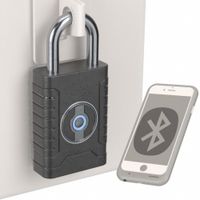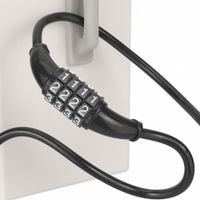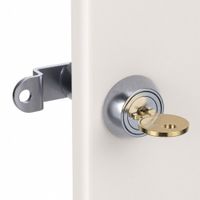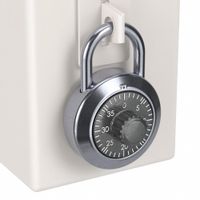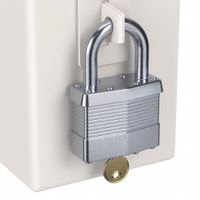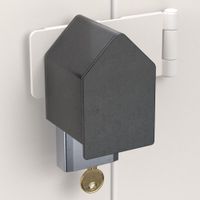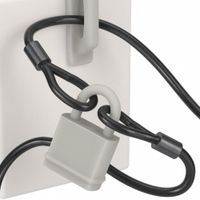Call +(254) 703 030 000 / 751 483 999 / 721 704 777
.....Read More
Frequently Asked Questions
What is the best type of lock for securing property?
The best type of lock for securing property depends on the specific needs and circumstances, but generally, high-security deadbolts, smart locks, and padlocks are considered effective.
1. **High-Security Deadbolts**: These are ideal for residential doors. Look for deadbolts with a Grade 1 rating from the American National Standards Institute (ANSI). Features like hardened steel bolts, anti-drill plates, and anti-pick pins enhance security. Brands like Medeco and Schlage offer reliable options.
2. **Smart Locks**: These provide convenience and security, allowing remote access and monitoring via smartphones. They often include features like keyless entry, temporary access codes, and integration with home automation systems. Ensure the smart lock has strong encryption and regular firmware updates to prevent hacking. August and Yale are popular brands.
3. **Padlocks**: For gates, sheds, or storage units, choose padlocks with hardened steel shackles and a high-security rating. Weather-resistant models are essential for outdoor use. Consider disc or shrouded padlocks to prevent bolt cutter attacks. Abus and Master Lock offer robust options.
4. **Electronic Locks**: Suitable for commercial properties, these locks offer keycard or biometric access, providing a high level of security and audit trails. Ensure they have backup power options and are regularly maintained.
5. **Chain and Cable Locks**: For securing bikes or outdoor equipment, use thick, hardened steel chains or cables with a high-security padlock. Kryptonite and OnGuard are reputable brands.
Ultimately, the best lock combines physical strength, resistance to tampering, and, if applicable, advanced technology features. Regular maintenance and proper installation are crucial to ensure maximum security.
How do padlocks work?
A padlock is a portable lock used to secure items or areas. It consists of a body, a shackle, and a locking mechanism. The shackle is the U-shaped metal bar that opens and closes, while the body houses the locking mechanism.
When locked, the shackle is secured within the body. The locking mechanism can be a pin-tumbler, combination, or disc-detainer system. In a pin-tumbler lock, the key aligns the pins at the shear line, allowing the plug to rotate and release the shackle. Each pin is split into two parts: a key pin and a driver pin. The key's unique cuts raise the pins to the correct height.
Combination padlocks use a rotating dial or set of dials. The correct sequence aligns internal wheels or discs, allowing the shackle to release. Each wheel has a notch that must align with a release mechanism.
Disc-detainer locks use rotating discs instead of pins. The key rotates the discs to align notches, allowing the shackle to open. This type is known for its resistance to picking.
Padlocks can be made from various materials, including brass, steel, or aluminum, offering different levels of security and weather resistance. Some padlocks have additional features like weatherproofing, anti-drill plates, or shrouded shackles to prevent cutting.
To unlock a padlock, the correct key or combination must be used. The key or combination manipulates the internal mechanism, releasing the shackle. When relocked, the shackle clicks back into place, and the mechanism secures it until the correct unlocking method is applied again.
What are the advantages of Bluetooth padlocks?
Bluetooth padlocks offer several advantages that enhance security and convenience:
1. **Keyless Access**: Bluetooth padlocks eliminate the need for physical keys, reducing the risk of losing keys or having them stolen. Access is granted via a smartphone app, making it easy to manage and control.
2. **Remote Management**: Users can lock or unlock the padlock remotely through a smartphone, providing flexibility and control over access, even from a distance.
3. **Access Sharing**: Temporary or permanent access can be shared with others via the app, allowing multiple users to unlock the padlock without needing to duplicate keys.
4. **Activity Tracking**: Many Bluetooth padlocks offer activity logs, allowing users to monitor who accessed the lock and when, enhancing security and accountability.
5. **Customizable Security Settings**: Users can set up personalized security features, such as auto-locking, tamper alerts, and notifications, to suit their specific needs.
6. **Durability and Weather Resistance**: Designed for outdoor use, many Bluetooth padlocks are built to withstand harsh weather conditions, ensuring reliability and longevity.
7. **Battery Efficiency**: Bluetooth padlocks are designed to be energy-efficient, often lasting several months on a single charge. Many models provide low-battery alerts to prevent unexpected lockouts.
8. **Integration with Smart Home Systems**: Some Bluetooth padlocks can integrate with smart home systems, allowing for seamless automation and control within a connected ecosystem.
9. **Enhanced Security Features**: Advanced encryption and security protocols protect against unauthorized access and hacking attempts, ensuring the padlock remains secure.
10. **User-Friendly Interface**: The accompanying apps are typically intuitive and easy to use, making it simple for users to manage access and settings.
Overall, Bluetooth padlocks combine modern technology with traditional security, offering a versatile and secure solution for protecting personal belongings.
How can I protect a padlock from being cut or smashed?
To protect a padlock from being cut or smashed, consider the following strategies:
1. **Material and Design**: Choose a padlock made from hardened steel or boron alloy, as these materials are more resistant to cutting and smashing. Opt for a shrouded shackle design, which covers most of the shackle and makes it difficult for bolt cutters to get a grip.
2. **Shackle Thickness**: Select a padlock with a thicker shackle. The thicker the shackle, the harder it is to cut. A shackle diameter of at least 10mm is recommended for enhanced security.
3. **Lock Placement**: Position the padlock in a way that limits access to the shackle. Use a lock box or a hasp that covers the shackle, making it difficult for tools to reach it.
4. **Security Chain or Cable**: Use a high-quality security chain or cable that is resistant to cutting. Chains made from hardened steel with hexagonal or square links are more difficult to cut than round links.
5. **Alarmed Padlocks**: Consider using an alarmed padlock that emits a loud sound when tampered with. This can deter thieves by drawing attention to their actions.
6. **Regular Maintenance**: Keep the padlock well-maintained to ensure it functions properly. Lubricate the lock mechanism regularly to prevent rust and corrosion, which can weaken the lock.
7. **Surveillance and Lighting**: Install security cameras and ensure the area is well-lit. Visible surveillance can deter potential thieves from attempting to cut or smash the padlock.
8. **Multiple Locks**: Use multiple locks for added security. Even if one lock is compromised, the others can still provide protection.
By implementing these measures, you can significantly enhance the security of your padlock and reduce the risk of it being cut or smashed.
What is the difference between a combination lock and a key lock?
A combination lock and a key lock are both mechanisms used to secure items, but they operate differently.
A combination lock uses a sequence of numbers or symbols to open. The user must input the correct combination, typically by turning a dial or entering numbers on a keypad. These locks do not require a physical key, which eliminates the risk of losing a key. Combination locks are often used on lockers, safes, and bicycles. They can be reset to a new combination if needed, offering flexibility. However, they can be vulnerable to being cracked if someone observes the combination or uses techniques to deduce it.
A key lock, on the other hand, requires a physical key to open. The lock mechanism is engaged or disengaged by inserting and turning the key. Key locks are widely used in doors, padlocks, and cabinets. They are generally straightforward to use and can be more secure against tampering if the key is kept safe. However, losing the key can be problematic, potentially requiring a locksmith to open the lock or replace it. Key locks can also be picked by skilled individuals, though high-security versions are designed to resist such attempts.
In summary, the main difference lies in the method of access: combination locks use a code, while key locks use a physical key. Each has its own advantages and disadvantages in terms of convenience, security, and risk of loss or unauthorized access.
How do built-in locker locks work?
Built-in locker locks typically function using a combination or key mechanism, designed to secure lockers in schools, gyms, and workplaces.
Combination locks are the most common type. They operate using a dial or keypad. In dial combination locks, the user turns a dial to align numbers with an internal mechanism. This mechanism consists of a series of wheels or cams, each corresponding to a number in the combination. When the correct sequence is entered, the wheels align, allowing a latch or bolt to retract and the locker to open. Keypad combination locks use a digital interface where users input a numeric code. The correct code sends an electronic signal to release the locking mechanism.
Key-operated locks use a physical key to engage or disengage the lock. The key turns a cylinder, which moves a bolt or latch into place. These locks are straightforward but require key management.
Some modern locker locks incorporate electronic or smart technology. These may use RFID cards, biometric scanners, or mobile apps for access. RFID locks use radio frequency identification to unlock when a registered card is presented. Biometric locks scan fingerprints or other unique biological features. Smart locks connect to smartphones via Bluetooth or Wi-Fi, allowing remote access and management.
Built-in locker locks are designed for durability and ease of use, often made from robust materials like steel or zinc alloy. They are integrated into the locker door, providing a streamlined appearance and reducing the risk of tampering. Maintenance involves regular checks for wear and ensuring the locking mechanism functions smoothly.
What are security cables and how are they used?
Security cables are physical deterrents used to prevent theft or unauthorized access to devices and equipment. They are typically made of strong materials like steel and are often coated with plastic to prevent damage to the items they secure. These cables are commonly used in various settings, including offices, retail environments, and public spaces, to secure laptops, projectors, bicycles, and other valuable items.
The primary function of security cables is to act as a physical barrier that deters potential thieves. They are often used in conjunction with locks, such as combination locks or key locks, to secure the cable to a fixed object, making it difficult to remove the protected item without the proper key or combination. Some security cables are designed with a loop at one end and a lock at the other, allowing them to be wrapped around an immovable object and locked in place.
In the context of electronics, many laptops and other portable devices come with a built-in security slot, often referred to as a Kensington slot, which is specifically designed to accommodate a security cable. Users can attach the cable to the device through this slot and secure it to a desk or other fixed structure.
Security cables are also used in retail settings to secure merchandise on display, preventing shoplifting while still allowing customers to interact with the products. In the case of bicycles, security cables can be used to lock the frame and wheels to a bike rack or other sturdy object.
Overall, security cables are a cost-effective and versatile solution for protecting valuable items from theft, providing peace of mind in both personal and professional environments.
How do I choose the right cable lock for my needs?
To choose the right cable lock, consider the following factors:
1. **Security Level**: Assess the security level you need. For high-risk areas, opt for thicker cables (at least 12mm) with a strong locking mechanism. For low-risk areas, a thinner cable may suffice.
2. **Material**: Look for cables made from braided steel, which offers better cut resistance. Vinyl or plastic coatings can protect against weather and prevent scratches on your property.
3. **Locking Mechanism**: Choose between key locks and combination locks. Key locks are generally more secure, but combination locks offer convenience as you don’t need to carry a key.
4. **Length and Flexibility**: Ensure the cable is long enough to secure your item to a fixed object. Flexible cables are easier to maneuver and can secure multiple items.
5. **Portability**: Consider the weight and size of the lock if you need to carry it frequently. Compact and lightweight options are ideal for portability.
6. **Brand and Reviews**: Opt for reputable brands known for quality and durability. Check customer reviews for real-world performance insights.
7. **Price**: Balance your budget with the level of security required. Higher-priced locks often offer better security features.
8. **Additional Features**: Some locks come with features like LED lights for nighttime use or alarms that trigger if tampered with.
9. **Warranty and Support**: Check for warranties or customer support options, which can be indicative of the manufacturer’s confidence in their product.
By evaluating these factors, you can select a cable lock that meets your security needs while offering convenience and reliability.
What are cam locks and where are they typically used?
Cam locks are a type of fastener commonly used to secure doors, cabinets, and other enclosures. They consist of a cylindrical body that houses a cam, a rotating metal piece that locks or unlocks the mechanism when turned by a key or tool. The cam is attached to the end of the lock body and rotates to engage or disengage with a strike plate or latch, securing the door or panel in place.
Typically, cam locks are used in a variety of applications due to their simplicity and effectiveness. They are often found in:
1. **Furniture and Cabinetry**: Cam locks are widely used in flat-pack furniture and cabinetry to secure panels and components together. They provide a strong, reliable connection that can be easily assembled and disassembled.
2. **Office Equipment**: Many office desks, filing cabinets, and storage units use cam locks to secure drawers and doors, protecting sensitive documents and personal items.
3. **Vending Machines and Display Cases**: Cam locks are used to secure access panels and doors on vending machines and display cases, preventing unauthorized access to the contents.
4. **Mailboxes and Lockers**: They are commonly used in mailboxes and lockers to ensure that only authorized individuals can access the contents.
5. **Electrical Panels and Enclosures**: Cam locks are used to secure access to electrical panels and enclosures, ensuring safety and preventing tampering.
Cam locks are favored for their ease of use, cost-effectiveness, and the security they provide. They come in various sizes and configurations to suit different applications, and can be made from materials like brass, steel, or zinc alloy for durability.
How can I ensure my locks are secure against unauthorized access?
To ensure your locks are secure against unauthorized access, consider the following strategies:
1. **High-Quality Locks**: Invest in high-security locks that are resistant to picking, bumping, and drilling. Look for locks with a high-security rating, such as those certified by ANSI/BHMA.
2. **Smart Locks**: Use smart locks that offer features like keyless entry, remote access, and activity logs. Ensure they have strong encryption and regularly update their firmware to protect against hacking.
3. **Rekeying**: Regularly rekey your locks, especially if you've lost a key or moved into a new home. This prevents old keys from being used to gain access.
4. **Deadbolts**: Install deadbolts on all exterior doors. Opt for a double-cylinder deadbolt for doors with glass panels to prevent someone from breaking the glass and unlocking the door from the inside.
5. **Strike Plates**: Reinforce door frames with heavy-duty strike plates and use long screws to secure them into the wall studs, making it harder to kick in the door.
6. **Door and Window Security**: Ensure doors and windows are made of strong materials and have secure locking mechanisms. Consider adding security bars or grilles for additional protection.
7. **Regular Maintenance**: Regularly inspect and maintain your locks to ensure they function properly. Replace any worn or damaged components immediately.
8. **Security Systems**: Integrate your locks with a comprehensive security system that includes alarms, cameras, and motion detectors for added protection.
9. **Access Control**: Limit the number of people who have keys or access codes. Use a master key system for better control and accountability.
10. **Professional Assessment**: Hire a professional locksmith to assess your security needs and recommend the best solutions tailored to your specific situation.
